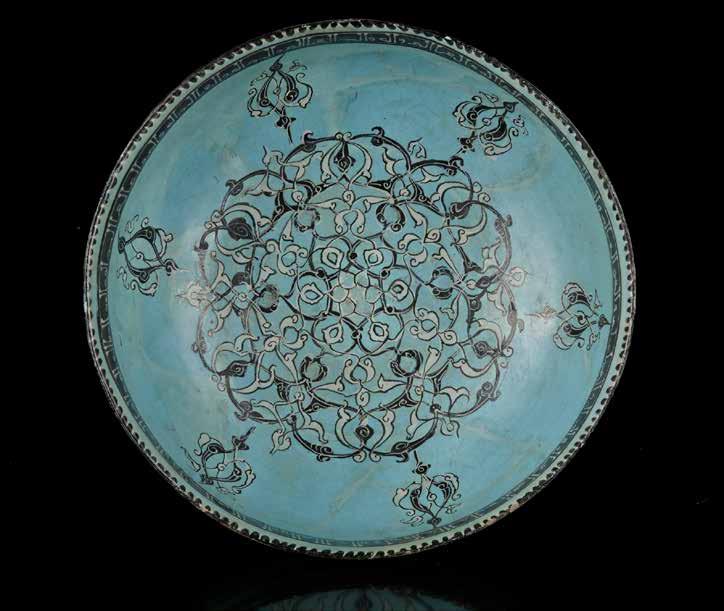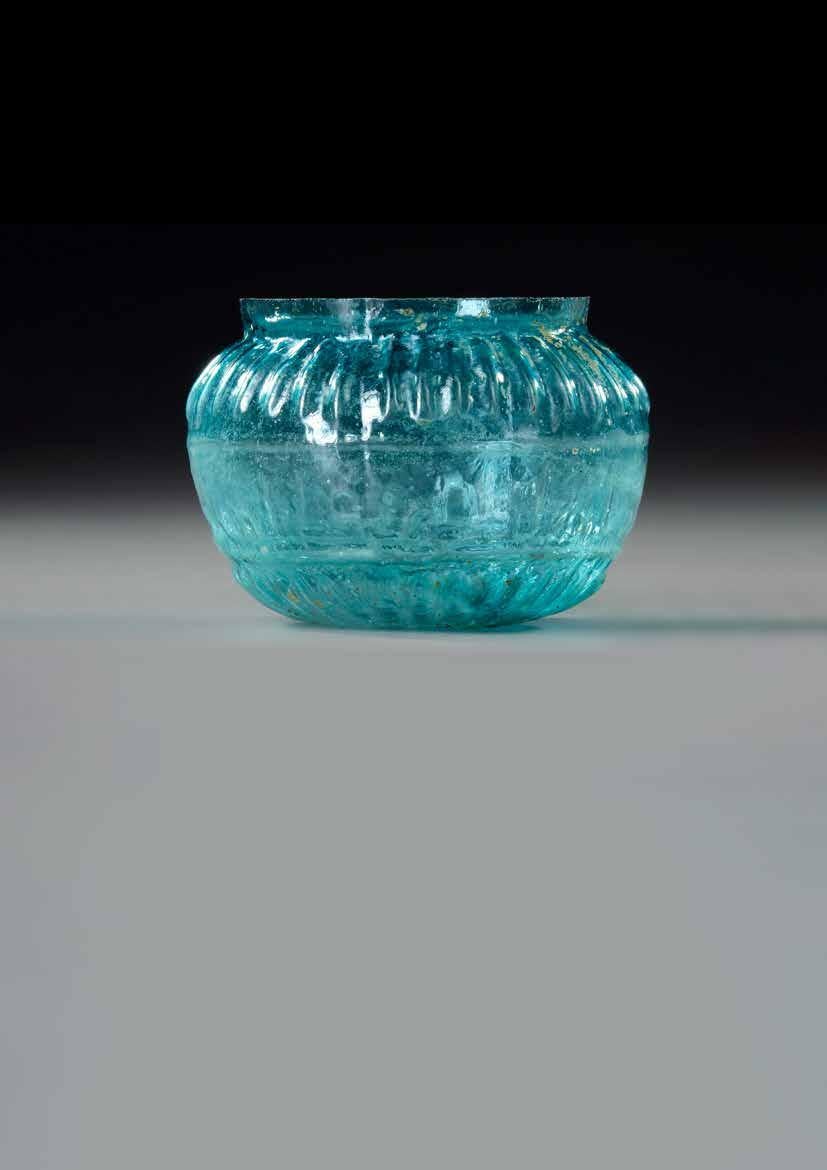
5 minute read
AN OTTOMAN ILLUMINATED CONCERTINA-FORM CALLIGRAPHIC MURAQQA, TURKEY, 18TH CENTURY
Arabic manuscript on paper, comprising 14 panels of calligraphy on album pages laid down on card, each panel with a large line of text in nastaliq script in black ink, surrounded by gilt floral motifs, margins ruled in gold and polychrome borders, the outer borders of colored paper sprinkled with gold, the last panel signed Abdulhalik. In deep brown leather morocco binding. 15 by 26 cm.
Estimate € 10.000 - € 20.000
Advertisement
Lot 56
TWO LARGE MAMLUK QURAN PAGES, EGYPT OR SYRIA


14TH CENTURY
Arabic manuscript on paper, 2ff. with 5 lines to each page, written in elegant black naskh script, gold verse markers enclosing the word “Ayat” outlined in black and gilt borders, marginal gilt and polychrome note roundel indicating “ the Hizb”.
Inscriptions: Surah An-Nisaa v.131-v.136 32 by 40 cm.
Estimate € 800 - € 1200
Lot 57
KHIZANAT AL-FIQH BY NASR IBN
MUHAMMAD ABU AL-LAYTH AL-SAMARQANDI
COPIED 1076 AH/1665 AD
Arabic manuscript on paper, 110 leaves each page with 17 lines written in black naskh script, titles and catchwords in red ink, ruled in green en red, marginal occasional notes in black and red, opening page with gilt and blue decoration. Copied in 1076 AH/1665 AD, with ownership statements and seals, in morocco brown binding with tooled floral decoration.
A book on Islamic jurisprudence (fiqh), deals with topics, such as: Marriage, Dower, divorce, Rights and Obligations of Spouses, Talqah, Wakf, Gift, Will and Inheritance. 12.5 by 19 cm.
Estimate € 2000 - € 4000
A PURPLE BLACK AND GOLD FOLIO, INDIA, DECCAN, BIJAPUR OR GOLCONDA, CIRCA 1600

Richly decorated in purple, black and gold, the central panel of the page with an elaborate tree and the second with foliage and birds, surrounded by identical borders filled with wild animals frolicking in the forest. 17.5 by 10.5 cm.
Estimate € 2000 - € 3000
Lot 58
TWO LARGE MAMLUK QURAN PAGES, EGYPT, 13TH CENTURY
Arabic manuscript on paper, interlinear Persian translation, with 7 lines to each page, written in large elegant black muhaqqaq script, with gold rosette verse markers outlined in blue, illuminated marginal medallion indicating the Juz and written in large thuluth gilt script.

Inscriptions: surah Adh-Dhariyat v.28-v.43, surah Al-Najm v.35- v.62 32 by 40 cm.
Estimate € 2000 - € 3000
Lot 60
A RARE YEMENI SWORD, MADE FOR THE SULTAN BADR BIN ABDULLAH AL
KATHERI, SOUTH ARABIA, EARLY 16TH CENTURY
A sword (saif) with flat slightly tapering double-edged blade, on one side with inscriptions in naskh script, the green mina enameled silver hilt with ribbed pommel, the guard and the grip carved with floral decorations. The leather covered scabbard body with two belt attachment rings, the locket and chape with a similar green mina enamlled and silver carved decoration with traces of gilding.
Length: 106 cm.
PROVENANCE
Private collection, France
Estimate € 30.000 - € 50.000
Early swords from the Arab cultures use to employ straight heavy blades. Curved shamshir style swords were adopted by many Arab communities and cultures around the 10th century, but in two places – Oman and Yemen straight blade swords continued to be used. The well known Omani Kattara sword was in use well into the 20th century. Its Yemeni “sister” is much less common.
The Yemeni sword with straight blade follows the style of earlier Islamic swords. Quite similar to Mamluk swords from the 13th century, not only with its straight blade but also the handle style with a ball shaped or similar rounded pommel. Use of early European blade is also common to these swords.

Catalogue Note
Badr Abu Tuwaireq, Badr bin Abdullah bin Ali bin Omar Al Kathiri, one of the greatest sultans of the Kathiri Sultanate.
He is considered the first Hadhrami sultan who persevered in unifying the regions of Hadramout and Mukalla. During his reign he reached the farthest limits of the Kathiri Sultanate. He knew that every tribe could declare its disobedience and rebellion and isolate its small areas of rule, harming the great unity of Hadramout and the region.
He was born in 1494, one year after his grandfather Jaafar occupied al-Shihr. He assumed the sultanate after his father in 1520, but the ambition of his brother Badr left him no room for action.
As soon as the year 1520 passed, Abu Tuwaireq was the de facto ruler of Hadramout, and his brother Muhammad remained the ruler of Dhofar. However, Abu Tuwaireq wrested Dhofar from his brother in the year 1540.
He became the ruler with the entire Kathiri state after he made his brother Muhammad ruler of the city of Al-Shihr, worked to form an army from other forces made up of the Turks of the Ottoman army, during the period of Caliph Suleiman the Magnificent, as well as from Jabal Yafea and their loyalists, and from some northern Yemeni regions, in order to be assured of their obedience and non-rebellion, and to fight the rebellious tribes against him in Nahd and Hamum.
During his reign of nearly 50 years (died in1569) had many wars with the Doan tribes, headed by the sheikhdom of the Amoudi family and Siban under the leadership of Sheikh Othman bin Ahmed Al-Amoudi Governor of the Doan Valley. Many of the tribes of Yafaa migrated during his reign to Hadhramaut and remained there to this day.
Lot 61
A SELJUK POTTERY BOWL, PERSIA, 13TH CENTURY
An outstanding hemispherical bowl, decorated with a black and white pattern painted under a beautiful turquoise glaze. The interlaced motifs intertwine harmoniously with each other, so as to form a large rosette at the center of the vessel. Several other patterns (6) frame the central decoration, representing a double flower, which is also composed of black and white elements. Two friezes of Arabic calligraphic inscriptions adorn the cup, like decorative ornaments. On the inside, Kufic characters, characterized by their angular shape, can still be deciphered; on the outside, the surface is decorated with the much more rounded, cursive naskhi script. Typologically, this cup can be classified in the group of Islamic lusterwares, whose successful process involved two firing sessions: the vessel was first fired to harden the clay, and was then given a second firing to produce the lustrous shine. This technique was probably invented in Iraq, the power center of the Abbasids, between the 8th and the 9th century. Widely used by the potters of Cairo under the Fatimid dynasty (10th and 11th century), it spread to the Syrian world in the 12th century. In Iran, the production of lusterware started in the late 12th century. The city of Kashan quickly became the major center of production.

Good overall condition, several restorations, repainting and minor losses.
Height: 8.7 cm.
Diameter: 20 cm.
Estimate € 15.000 - € 20..000
PROVENANCE
Private collection, Sitzerland, acquired 06.2009 on the French art market. Ex-collection Engel Gros. With a label that reads ‘Engel Gros’.
Bibliography
PANCAROGLU O., Perpetual Glory, Medieval Islamic Ceramics from the Harvey B. Plotnik . Collection, Chicago, 2007, pp. 105-106, nos. 63-64. Terres d’Islam, Les collections de céramiques moyen-orientale du Musée Ariana à Genève, Geneva, 2014, nos. 50-55, pp. 70-73. WATSON O., Ceramics from the Islamic Lands, Kuwait National Museum: The Al-Sabah Collection, London, 2004, pp. 332-337.











